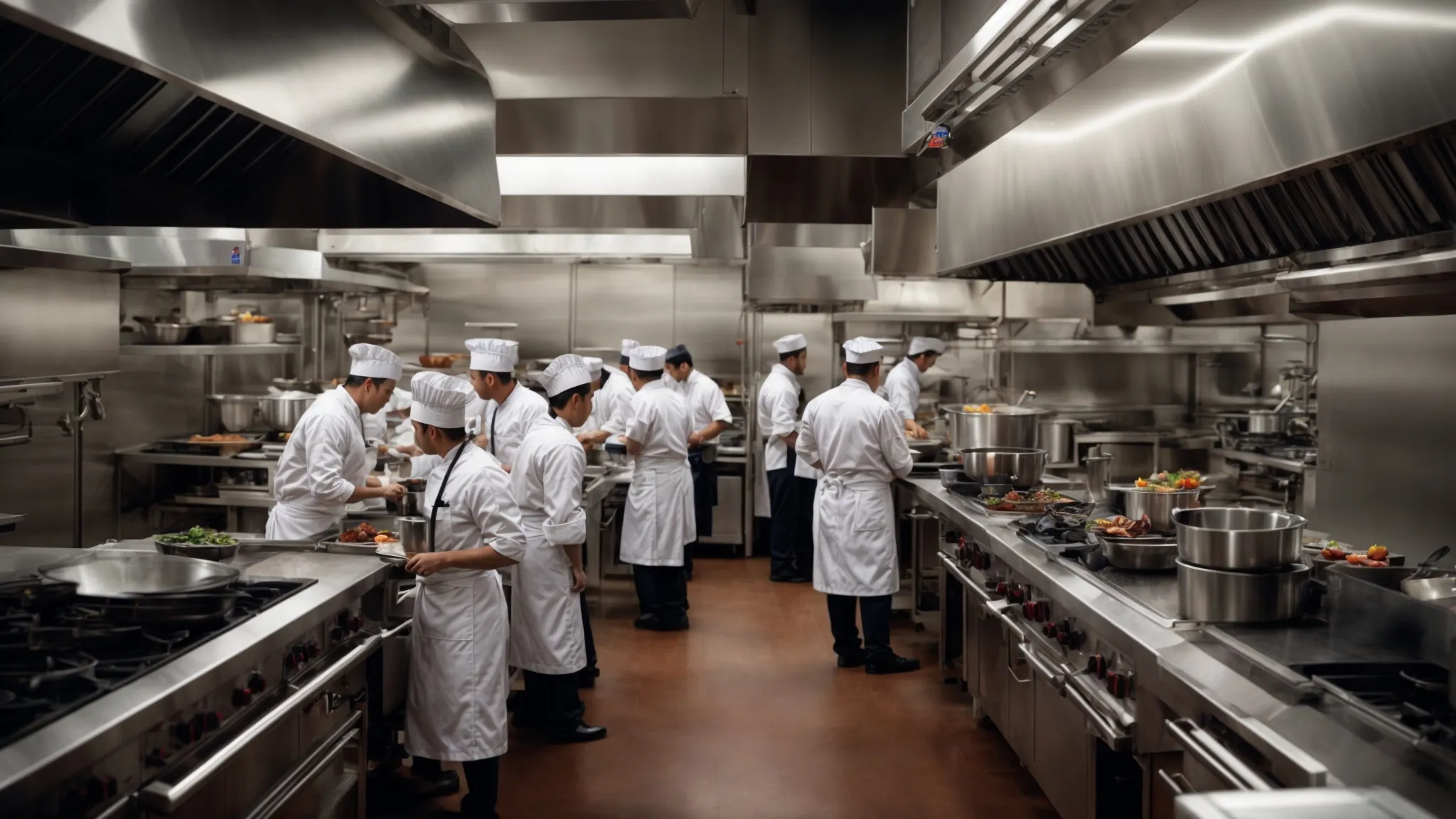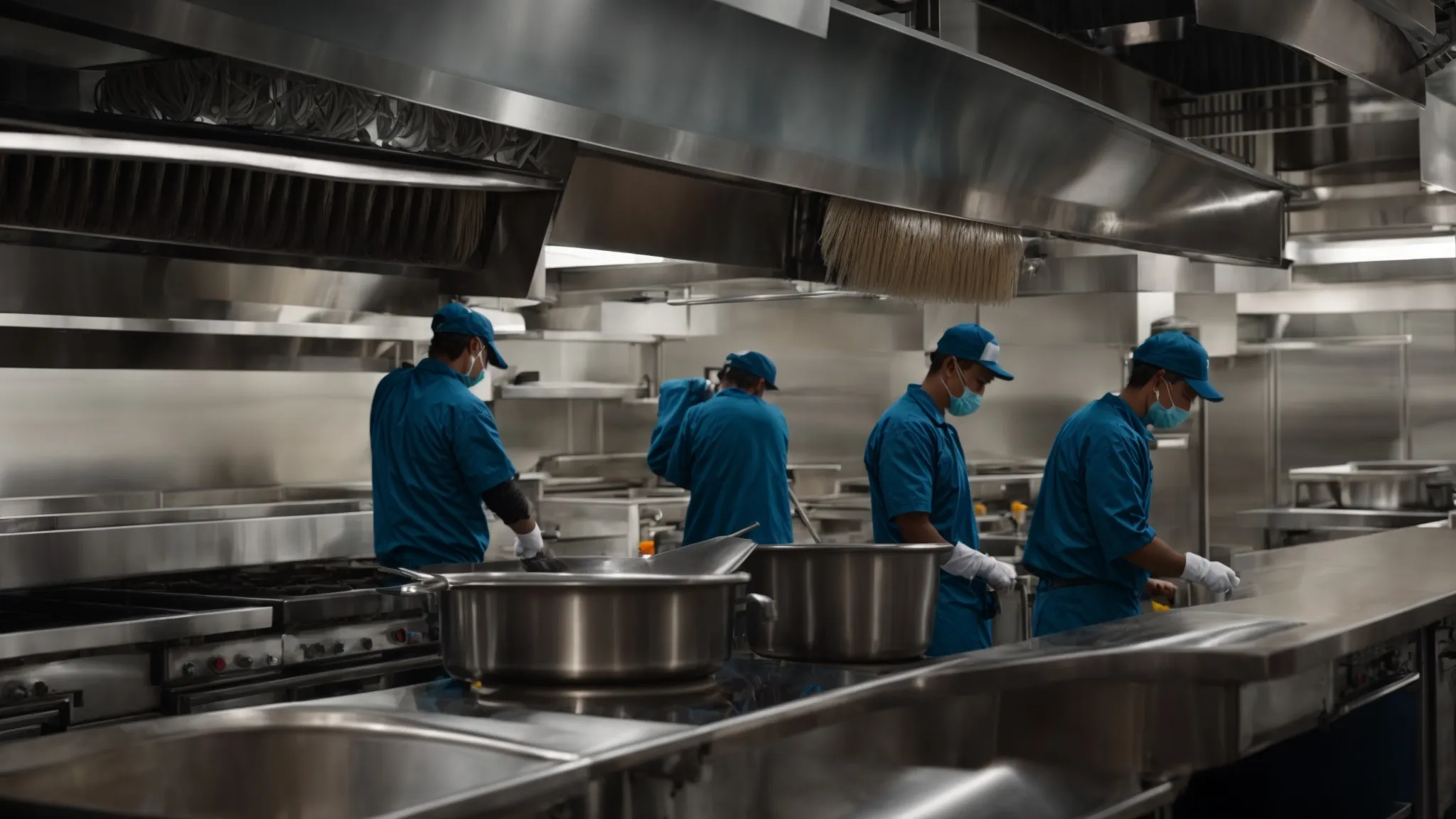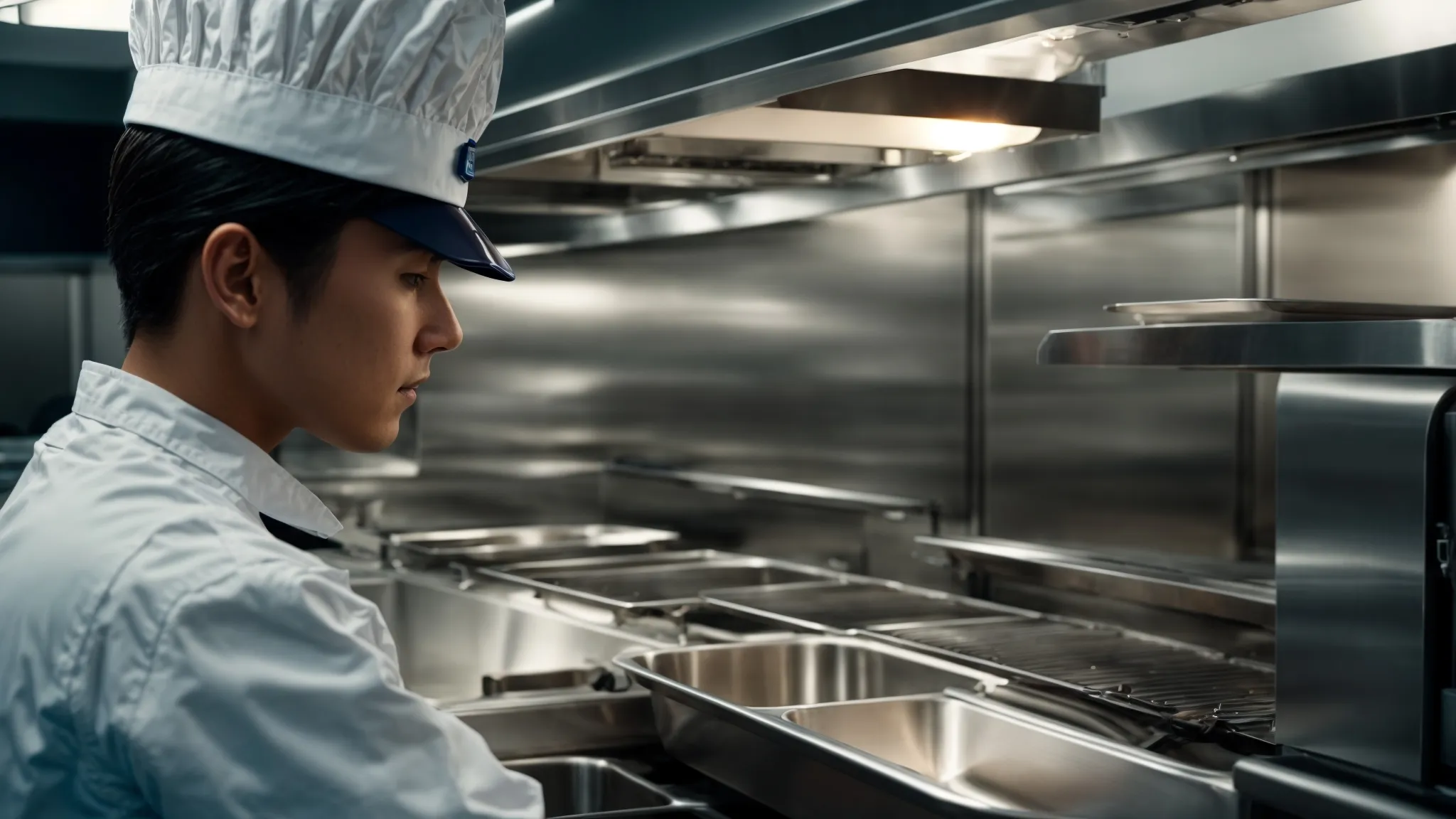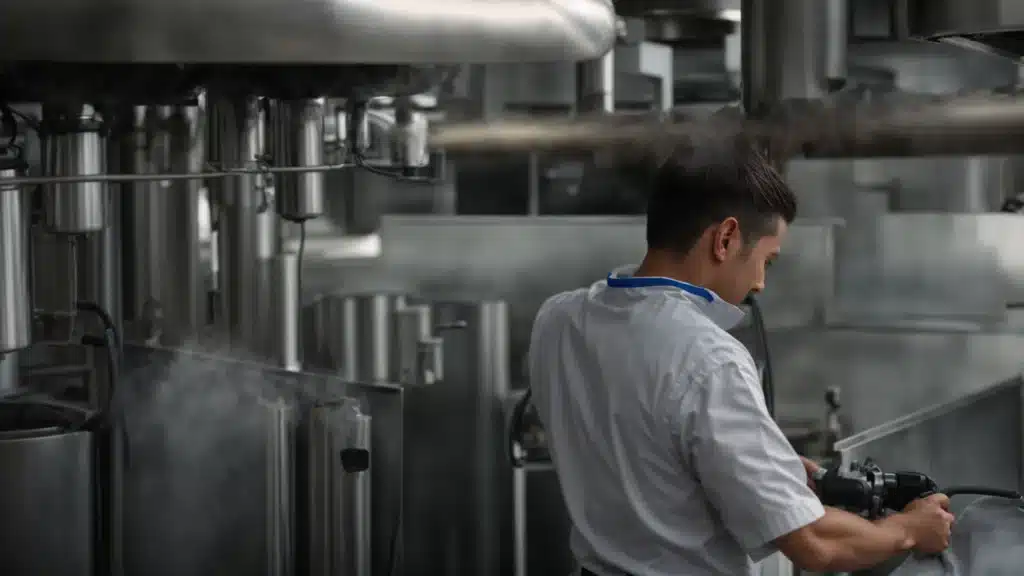Understanding Hood Cleaning Regulations and Compliance
Cleaning Rules: A Guide to Compliance
Navigating the maze of hood cleaning regulations is a critical endeavor for any restaurant or commercial kitchen operator in Ontario, Canada.
Understanding these rules ensures the establishment’s and its patrons’ safety and optimizes kitchen efficiency and functionality.
This guide will explore the cornerstone of kitchen safety – compliance with hood cleaning and kitchen exhaust maintenance standards, including the pivotal role of NFPA 96 in setting these benchmarks.
From grasping the basics to adopting best practices for compliance, the journey to a safer, more efficient kitchen starts here.
Keep reading to unlock the essentials of hood cleaning compliance and how Ontario Hood Cleaning can be your ally in this crucial task.
Key Takeaways
- Professional Hood Cleaning Services Simplify Compliance With Safety and Regulatory Standards in Commercial Kitchens
- Regular Maintenance and Cleaning of Hood and Exhaust Systems Are Vital for Fire Prevention and Kitchen Hygiene
- Certified Professionals Ensure Thorough Cleaning and Adherence to the Latest Industry Standards and Regulations
- Documentation of Cleaning Sessions Is Crucial for Proving Compliance During Inspections and Audits
- Leveraging Technology for Reminders and Compliance Management Streamlines Safety and Cleanliness Efforts in Kitchens
Understanding the Basics of Hood Cleaning Regulations
Contact Us
Understanding the complex labyrinth of Ontario Hood Cleaning regulations is critical for maintaining operational compliance within any commercial kitchen.
The requirements, governed by an array of bodies and standards, differentiate notably between local and federal levels.
These regulatory frameworks are designed to ensure safety, efficiency, and environmental compliance.
Beyond legal adherence, knowing which rules apply to different types of kitchens—from bustling restaurants in urban centers to compact food trucks like Ontario Hood Cleaning—is the backbone for establishing effective cleaning and maintenance protocols.
While intricate, Navigating through these regulations is a pivotal step in safeguarding the establishment and its patrons against the risks of neglect.
Identifying the Governing Bodies and Standards
The journey through the regulations of hood cleaning is largely overseen by multiple organizations, each bearing its unique set of codes and standards. Notably, local health departments play a significant role in enforcing these Hood Cleaning regulations at the municipal level, ensuring that all commercial kitchens adhere to the highest standards of cleanliness and safety.
On a national scale, agencies such as the National Fire Protection Association (NFPA) and the American National Standards Institute (ANSI) dictate comprehensive guidelines that cover everything from the installation to the maintenance of kitchen exhaust systems. These standards serve to mitigate fire risks and maintain air quality, highlighting the importance of Ontario Hood Cleaning, and professional cleaning.
To bridge the gap between local and national expectations, a table of governing bodies and their respective Areas Served provides a clear reference for restaurants and food service establishments:
| Governing Body | Scope of Regulation | Key Standards |
|---|---|---|
| Local Health Departments | Municipal | Sanitation and Safety |
| National Fire Protection Association (NFPA) | National | NFPA 96: Standard for Ventilation Control and Fire Protection of Commercial Cooking Operations |
| American National Standards Institute (ANSI) | National | ANSI/UL 300: Fire Testing of Fire Extinguishing Systems for Protection of Restaurant Cooking Areas |
Understanding the interplay between these entities ensures not only compliance but fosters a proactive approach to mitigating risks associated with commercial kitchen operations.
Differentiating Between Local and Federal Compliance Requirements
The task of aligning with both local and federal hood cleaning regulations, while seemingly daunting, is essential for restaurant and commercial kitchen operators. Local jurisdictions might impose specific guidelines that reflect the unique needs and safety concerns of their communities, potentially requiring Ontario Hood Cleaning to take additional measures beyond national standards. This duality demands a nuanced approach, tailored to satisfy both sets of requirements without compromising on compliance or safety.
At the federal level, the guidelines provided by organizations such as the NFPA and ANSI offer a broad framework designed to ensure the health and safety of both workers and patrons across all states. These standards focus on the prevention of fires and maintenance of air quality, setting a baseline for kitchen exhaust system cleanliness that applies universally. Restaurants in Areas Served must integrate these overarching directives with local mandates to create a comprehensive hood and exhaust cleaning protocol.
Understanding the distinction between local Ontario Hood Cleaning and federal compliance requirements is critical for avoiding penalties and ensuring the continuous operation of a commercial kitchen. Operators must stay informed about changes in both sets of regulations, as adjustments can occur that might affect operational practices. By securing services from a well-versed professional cleaning company that is experienced in navigating these complex requirements, establishments can ensure they remain within the bounds of the law while protecting their staff and customers.
Recognizing the Types of Kitchens Affected by These Rules
The spectrum of establishments grappling with hood cleaning regulations is extensive, touching on any venue that utilizes a commercial kitchen setup. From high-volume restaurants nestled in the heart of urban centres through to hotel kitchens that serve guests at all hours of the day, each bears the responsibility of adhering to Ontario Hood Cleaning stringent cleaning standards. Not just limited to these, even compact mobile food vendors, like food trucks, fall under these comprehensive guidelines, demonstrating the widespread impact of such regulations.
Specifically, the type of kitchen operation dictates the intensity and frequency of Ontario Hood Cleaning and maintenance required. Facilities with heavy usage, such as 24/7 diners or establishments known for their fried cuisines, experience a larger volume of grease buildup, necessitating more frequent interventions by hood cleaning professionals. Contrastingly, a small cafe that only lightly uses its kitchen may have different, albeit still critical, cleaning schedules and requirements under the same regulations.
Operators across all these diverse kitchen types need to maintain a keen awareness of how regulations apply specifically to their circumstances at Ontario Hood Cleaning. Engaging a professional service like Ontario Hood Cleaning presents a tailored solution, ensuring that compliance is met without disruption to the bustling rhythm of kitchen operations. This proactive approach not only abides by the law but significantly raises the bar for safety and cleanliness, benefiting everyone from kitchen staff to the end consumer.
Navigating the maze of hood cleaning regulations is just the start. Now, let’s explore how adhering to these rules can transform your kitchen’s safety and efficiency!
The Importance of Compliance for Safety and Efficiency
Contact Us, Our Blog, Areas Served, Ontario Hood Cleaning
Ensuring compliance with hood cleaning regulations is not merely about ticking boxes on a list of requirements; it’s a commitment to safeguarding the overall safety and efficiency of a commercial kitchen.
By directly linking hood cleaning to fire prevention, establishments can dramatically reduce their risk of devastating kitchen fires.
Regular maintenance activities extend beyond cleanliness, significantly affecting kitchen hygiene and the wellbeing of staff who spend countless hours within these environments.
It’s also crucial to recognize the tangible consequences of non-compliance, which can impact a business far beyond mere fines, potentially leading to forced closures or severe reputational damage.
This section delves into understanding the crucial role that adherence to hood cleaning rules plays in maintaining a safe, efficient, and compliant kitchen operation.
Exploring the Direct Link Between Hood Cleaning and Fire Prevention
The correlation between diligent hood cleaning and mitigating fire hazards in commercial kitchens is profound. Accumulated grease within exhaust systems serves as a highly flammable substance that, if ignited, can lead to catastrophic outcomes. Ontario Hood Cleaning, with its comprehensive approach to kitchen exhaust cleaning, plays a pivotal role in removing this risk.
Regular maintenance and cleaning of hood and exhaust systems by professional teams like those at Ontario Hood Cleaning effectively break the chain of events that could lead to a fire. This specialized service not only clears grease but also inspects for potential vulnerabilities within the system, ensuring that any fire safety concerns are immediately addressed. Such preemptive measures are essential for maintaining a secure environment.
By adhering to the stringent standards set forth by governing bodies, restaurant owners entrust companies like Ontario Hood Cleaning to safeguard their establishments against the threat of kitchen fires. The process of hood cleaning, when executed thoroughly, acts as an essential firewall, protecting both the tangible assets of a business and the lives of those within it. As such, the importance of choosing a reliable service provider cannot be overstated.
How Regular Maintenance Impacts Kitchen Hygiene and Staff Wellbeing
Regular maintenance of kitchen exhaust and hood systems plays a pivotal role in upholding a high standard of hygiene within commercial kitchens. By eradicating grease, debris, and other contaminants from these areas, Ontario Hood Cleaning ensures that kitchens are not only clean but also safe for food preparation. This attention to cleanliness helps prevent the spread of bacteria and pathogens, contributing to a healthier environment for both staff and patrons.
The positive impact on staff wellbeing from maintaining a clean kitchen environment is undeniable. Employees working in well-ventilated, grease-free, and sanitary conditions experience less stress and discomfort, leading to higher morale and productivity. Ontario Hood Cleaning’s commitment to thorough kitchen and equipment cleaning alleviates potential health hazards, allowing staff to focus on delivering exceptional culinary experiences without concern for their own safety.
Moreover, engaging in regular professional hood and exhaust cleaning services like those offered by Ontario Hood Cleaning minimizes the risk of pest infestations, a common issue in areas where grease and food remnants accumulate. A clean kitchen deters pests, which are attracted to food waste and grease, thereby enhancing the overall hygiene of the restaurant. This not only protects the health of the employees but also preserves the establishment’s reputation for cleanliness and quality.
The Consequences of Non-Compliance on Your Business
Non-compliance with hood cleaning regulations poses significant legal and financial risks for restaurant owners. Failing to adhere to the stringent standards set by governing bodies can result in hefty fines, which can strain the finances of any establishment. Such penalties underscore the critical nature of regular and professional hood and exhaust cleaning services.
Additionally, neglecting hood cleaning obligations not only exposes a business to legal ramifications but also jeopardizes its operational continuity. Health and safety inspections that uncover violations may lead to temporary shutdowns until compliance is achieved, disrupting business and affecting revenue. This scenario stresses the value of partnering with competent services like Ontario Hood Cleaning to maintain uninterrupted operations.
A reputation for lax safety and hygiene standards can inflict lasting damage on a restaurant’s image. Word of non-compliance and the associated risks can quickly erode customer trust, making it challenging to regain. A tarnished reputation due to failure to meet hood cleaning regulations can deter patrons, potentially leading to a decline in clientele and loss of business. In the competitive restaurant industry, maintaining a stellar reputation for safety and cleanliness is non-negotiable.
Understanding the need for compliance in commercial kitchens sets the stage for a deeper exploration. Let’s now unlock the secrets of NFPA 96 and its impact on kitchen safety and efficiency.
Deciphering NFPA 96 and Its Requirements for Commercial Kitchens

As part of ensuring a safe, efficient, and legislation-abiding commercial kitchen, it is crucial to understand the intricacies of NFPA 96, a keystone in the governance of hood and exhaust system maintenance.
This standard outlines not only how often different types of kitchens should schedule professional cleanings but also details the requirements surrounding grease filters and the entirety of the exhaust systems.
For kitchen managers and owners, grappling with these mandates requires a comprehensive strategy, one that involves regular check-ups, adherence to specified cleaning intervals, and an unwavering commitment to meeting every stipulation.
The forthcoming segments aim to demystify NFPA 96, offering a deep dive into the standard’s cleaning frequency guidelines, the specific requirements for grease filters and exhaust systems, and providing a meticulously crafted compliance checklist designed to assist kitchen managers and owners in navigating this pivotal aspect of kitchen maintenance.
Breaking Down the Standard’s Cleaning Frequency Guidelines
Understanding NFPA 96’s cleaning frequency guidelines is essential for all commercial kitchens to maintain compliance and ensure safety. The standard mandates that the frequency of cleaning should be commensurate with the volume of cooking and type of food being prepared, emphasizing the need for a tailored approach to hood and exhaust system maintenance.
Restaurants that experience high-volume cooking, especially those specializing in greasy or smoky foods, require more frequent hood cleanings, sometimes as often as monthly. This directive ensures that grease buildup, a major fire hazard, is diligently managed, protecting both the establishment and its patrons from potential dangers.
On the other hand, establishments with lower cooking volumes, such as seasonal operations or those with limited frying, may adhere to a less stringent cleaning schedule, possibly extending to a semi-annual basis. This flexibility within NFPA 96 allows for efficiency in maintenance operations while upholding the core objective of kitchen safety and compliance.
Understanding the Requirements for Grease Filters and Exhaust Systems
NFPA 96 sets forth rigorous standards for grease filters and exhaust systems, central to mitigating fire hazards in commercial kitchens. These regulations require the utilization of high-quality filters that trap grease effectively, preventing it from entering the exhaust ducts where it can ignite and cause a fire. The choice of appropriate filters and their maintenance are thus key to compliance and safety.
For exhaust systems, the standard mandates regular inspection and cleaning to ensure they remain free of grease accumulation. Ontario Hood Cleaning excels in this area, offering specialized services that align with NFPA 96’s stipulations. By ensuring that exhaust systems operate efficiently, they play a crucial role in maintaining a kitchen’s air quality and reducing fire risks.
Adhering to NFPA 96’s requirements for grease filters and exhaust systems demands a collaborative effort between kitchen operators and professional cleaning services. Ontario Hood Cleaning’s expertise ensures that both components receive the attention they require for optimal function, fostering a safe and compliant kitchen environment. This partnership not only secures compliance but also enhances the long-term operational efficiency of culinary establishments.
Compliance Checklist for Kitchen Managers and Owners
Ensuring that a commercial kitchen remains within the bounds of regulation begins with a solid understanding and application of NFPA 96’s guidelines. It is imperative for kitchen managers and owners to regularly consult this standard: a practice that safeguards against overlooks and ensures every facet of their operation meets regulatory approval.
| Compliance Item | Required Action | Frequency |
|---|---|---|
| Hood and Exhaust System Cleaning | Schedule professional cleaning | Depending on cooking volume and type |
| Grease Filter Maintenance | Inspect and replace filters as necessary | Regularly |
| Exhaust System Inspection | Conduct thorough inspections | At least annually |
Initiating a routine for inspecting and maintaining grease filters and exhaust systems is non-negotiable for abiding by NFPA 96’s edicts. Ontario Hood Cleaning’s professional services can alleviate this burden, ensuring that establishments are not only compliant but operate at an optimal safety level. Their expertise in navigating the specifics of regulatory requirements represents a crucial partnership for kitchen managers dedicated to maintaining high standards of safety and cleanliness.
A compliance checklist should serve as a tangible reference point throughout a kitchen’s operational calendar. By aligning maintenance and cleaning activities with the recommendations outlined in NFPA 96, kitchen managers and owners position their establishments to avoid the pitfalls of non-compliance. Ensuring this alignment molds a path to a safer, more efficient, and legally sound kitchen environment, encapsulating the essence of responsible management in the food service industry.
Mastering NFPA 96’s mandates unlocks the door to safer commercial kitchens. Let’s embark on a journey to ensure your hood cleaning meets these standards, one step at a time.
Step-by-Step Guide to Achieving Hood Cleaning Compliance

Maintaining a commercial kitchen’s compliance with hood cleaning regulations is an ongoing process that requires meticulous attention to detail and structured planning.
This journey begins with the establishment of routine cleaning schedules that adhere to both local and federal guidelines, ensuring that all operations are up to date.
Selecting certified professionals for the task of hood and exhaust cleaning represents a critical step, as their expertise determines the effectiveness of grease and hazard removal.
Furthermore, ensuring every component of the kitchen’s exhaust system meets rigorous inspection standards is essential for both safety and compliance.
Together, these steps form a comprehensive strategy for navigating the complexities of hood cleaning rules, setting the foundation for a kitchen environment that is safe, compliant, and efficient.
Scheduling and Documenting Routine Cleanings
Scheduling routine cleanings is the cornerstone of maintaining compliance and ensuring the safety and efficiency of commercial kitchens. Ontario Hood Cleaning recommends establishing a regular cleaning cycle based on the kitchen’s volume of cooking and the types of food prepared. This proactive approach helps avoid grease buildup, a primary fire hazard, and ensures kitchens meet both local and national cleanliness standards.
Documenting each cleaning session provides a verifiable record that verifies compliance with health and safety regulations. Ontario Hood Cleaning equips its clients with detailed reports after each service, cataloging the extent of cleaning performed and any potential issues identified. This documentation is invaluable during inspections, serving as proof of diligent maintenance and adherence to required standards.
Moreover, maintaining an up-to-date cleaning log aids in planning future cleaning sessions and budgeting for maintenance expenses. It allows kitchen managers to anticipate when their next cleaning should occur, preventing any lapse in compliance. Ontario Hood Cleaning assists its clients in developing a tailored cleaning schedule that aligns with regulatory demands and the specific needs of their operations, ensuring kitchens operate within legal frameworks at all times.
Selecting Certified Professionals for Hood and Exhaust Cleaning
Choosing certified professionals like Ontario Hood Cleaning is indispensable for restaurants seeking to navigate the intricacies of hood and exhaust system compliance. These experts bring a wealth of experience and specialized knowledge that ensures the cleaning process is thorough, meeting all regulatory requirements while effectively mitigating risks associated with grease buildup. Their certification is a testament to their proficiency and dedication to upholding the highest standards of kitchen safety and hygiene.
Engaging a certified team guarantees that cleaning protocols align with the latest industry standards and regulatory guidelines. Ontario Hood Cleaning stays abreast of evolving regulations and adopts the most advanced cleaning techniques, ensuring that their clients’ kitchens remain compliant and operational. This level of expertise not only provides peace of mind but also shields establishments from potential fines and operational disruptions due to non-compliance.
The selection process should emphasize the professional’s track record of delivering exceptional cleaning services and their commitment to customer satisfaction. Ontario Hood Cleaning excels in these areas, offering comprehensive cleaning solutions tailored to each kitchen’s unique needs. By prioritizing certified professionals for hood and exhaust cleaning, restaurant owners and managers secure the functionality and safety of their kitchens, ensuring a smooth path toward compliance and operational excellence.
Ensuring All Components Meet Inspection Standards
Ensuring all components of a kitchen’s exhaust system align with inspection standards plays a pivotal role in sustaining compliance and enhancing safety measures. Ontario Hood Cleaning emphasizes the importance of a comprehensive review, during which every segment of the system is meticulously examined for grease accumulation, structural integrity, and operational functionality. This meticulous scrutiny ensures that each cleaning operation effectively contributes to the overall safety and efficiency of the kitchen’s operations.
During inspections, special attention is drawn to the exhaust fan, ductwork, and grease filters, as these components are critical to the system’s performance and fire safety. Ontario Hood Cleaning’s team employs state-of-the-art equipment and techniques to assess these elements, ensuring they meet or exceed the rigorous standards set forth by NFPA 96 and local health codes. This approach minimizes fire risks and supports a healthy working environment.
By adhering to these stringent inspection and cleaning protocols, Ontario Hood Cleaning guarantees that commercial kitchens not only comply with current regulations but are also prepared for unannounced health and safety inspections. This proactive stance on maintenance fosters a culture of safety and reliability, establishing the establishment as a responsible and conscientious member of the food service community.
Transitioning from mastering the compliance essentials to ensuring full adherence, the story unfolds. Now, embrace the journey toward leveraging expert services for unbeatable compliance and safety.
Leveraging Professional Services for Compliance and Safety

Securing the services of a hood cleaning professional is pivotal in adhering to stringent kitchen safety and regulatory standards.
Navigating through the selection of providers, understanding the scope of the cleaning process, and leveraging the post-service documentation for ongoing compliance forms the bedrock of a successful maintenance strategy.
This section embarks on elucidating the critical steps in choosing the right hood cleaning service provider, shedding light on what operators can anticipate during the cleaning execution, and exploiting the benefits of comprehensive support and documentation post-cleanup.
Each element is geared towards fortifying safety measures and streamlining compliance efforts, enabling culinary establishments to foster an environment that prioritizes hygiene and patron well-being.
How to Choose a Hood Cleaning Service Provider
Identifying the ideal hood cleaning service provider demands due diligence and a focus on their track record and expertise. Restaurants and commercial kitchen operations should prioritize finding a partner like Ontario Hood Cleaning, known for their deep understanding of the industry’s standards and regulations. This ensures not only compliance but a commitment to safety and efficiency.
Analyzing verifiable reviews and testimonials plays a crucial role in selecting a hood cleaning service. A company’s past performance, as shared by other businesses, offers valuable insight into their reliability and the quality of their work. A service provider that consistently receives high praise for thorough cleanings and professional conduct is more likely to deliver satisfactory results.
Finally, assessing the breadth of services offered by the hood cleaning company ensures a comprehensive approach to kitchen maintenance. A provider should offer not just hood and exhaust cleaning but also complementary services such as equipment cleaning and grease containment solutions. Companies that present a full suite of services showcase their capability to address all aspects of kitchen hygiene and safety.
What to Expect During a Professional Hood Cleaning Service
Engaging Ontario Hood Cleaning for professional hood cleaning services ushers in a thorough and systematic cleaning process. The team arrives equipped with specialized tools and eco-friendly cleaning solutions, ensuring that every inch of the kitchen’s hood and exhaust system is meticulously freed from grease and grime. This deep cleaning not only meets but often surpasses the rigorous standards set by regulatory bodies.
During the service, Ontario Hood Cleaning’s professionals conduct a detailed inspection of the hood, ducts, and exhaust fans to identify potential issues or hazards. Their trained eyes spot problems that could compromise safety or efficiency, addressing them promptly. Clients can expect a transparent and informative approach, where any concerns are communicated clearly, ensuring that the kitchen’s operations can proceed without interruption.
After completing the hood cleaning service, Ontario Hood Cleaning provides comprehensive documentation that outlines the work performed, areas inspected, and any recommendations for future maintenance. This record serves as tangible proof of compliance with health and safety regulations, crucial for any commercial kitchen’s documentation. Restaurateurs and kitchen operators gain peace of mind, knowing their establishments adhere to the highest standards of cleanliness and safety.
Making the Most of Post-Cleaning Documentation and Support
After receiving professional hood cleaning services, establishments are endowed with detailed documentation of the work undertaken. This documentation is an invaluable asset that proves adherence to stringent regulatory requirements, offering establishments a solid defense during inspections and audits.
Further leveraging the support provided by professional services, kitchen operators can engage in constructive dialogue with their cleaning providers. This encourages a proactive stance towards maintenance, allowing for the early detection of potential issues and the formulation of strategies to prevent future regulatory or safety lapses.
Finally, this post-cleaning phase presents an opportunity to assess the effectiveness of the cleaning protocols. Establishments can collaborate with their service providers to fine-tune cleaning schedules and methods, ensuring ongoing compliance and the safety of both patrons and staff without compromising operational efficiency.
Embrace the dynamic world of kitchen safety! The journey continues as we explore the latest updates in hood cleaning regulations.
Keeping Up With Changes in Hood Cleaning Regulations

In the fast-paced culinary world, restaurant owners and kitchen managers must remain vigilant to stay ahead of regulatory changes that affect hood cleaning and kitchen safety.
Adapting to updates in safety standards and regulations is not just about compliance; it’s about protecting your establishment, your employees, and your patrons from potential hazards.
Implementing new practices becomes pivotal for ongoing compliance, ensuring that every change in regulation translates into improved safety measures in your kitchen.
Moreover, leveraging technology for compliance management and reminders streamlines this continuous adaptation process, making it easier for businesses to maintain their focus on what they do best—serving exceptional food in a safe and clean environment.
Staying Informed About Updates in Safety Standards and Regulations
Staying abreast of updates in safety standards and regulations is indispensable for the continuous compliance of commercial kitchens. Regulatory bodies periodically adjust standards to enhance safety, efficiency, and environmental friendliness within the food service industry. By proactively monitoring these changes, kitchen operators can ensure their practices align with the latest requirements.
One effective strategy for maintaining current knowledge includes subscribing to updates from relevant governing bodies and industry associations. These organizations frequently disseminate information vital to kitchen operations, including changes in hood cleaning regulations and safety protocols:
- Subscribing to newsletters from regulatory bodies.
- Participating in professional forums and webinars.
- Engaging with industry associations for the latest compliance guidelines.
Lastly, collaboration with a reputable hood cleaning service provider, such as Ontario Hood Cleaning, can be instrumental. These professionals are often the first to be informed about changes in regulations, as their business depends on staying compliant. Establishing a partnership with a trusted provider ensures that your kitchen benefits from the most current practices in hood and exhaust system maintenance.
Implementing New Practices for Ongoing Compliance
Adapting to the evolving landscape of hood cleaning regulations requires a commitment to continuous learning and improvement. Restaurants and commercial kitchens must embrace new cleaning technologies and methods to ensure their practices meet the latest standards. This willingness to innovate not only safeguards compliance but enhances overall operational efficiency.
Staff training is paramount to implementing new practices successfully. Regular, up-to-date sessions ensure that kitchen staff understand the importance of compliance with hood cleaning norms and are familiar with the latest cleaning techniques and safety protocols. Effective training turns employees into a vigilant team that upholds cleanliness and safety standards:
| Training Focus | Goals | Frequency |
|---|---|---|
| Latest Cleaning Techniques | Ensure staff are equipped with knowledge of efficient and effective cleaning procedures | Semi-annually |
| Safety Protocols | Minimize risks associated with kitchen operations and ensure a safe working environment | Annually |
| Regulatory Compliance | Keep the team updated on regulatory changes and internal compliance checks | As regulations update |
Investing in technology for compliance management also plays a pivotal role in upholding standard practices. Automated reminders for hood cleaning schedules, digital logs of cleaning sessions, and instant updates on regulatory changes empower establishments to maintain an unblemished record of compliance and safety, ushering in an era of streamlined kitchen management.
Leveraging Technology for Compliance Management and Reminders
Embracing technology revolutionizes how commercial kitchens manage compliance with hood cleaning regulations. Digital systems streamline the process, offering a seamless way to track cleaning schedules and compliance documentation. This makes adherence to evolving safety standards more manageable and less susceptible to human error.
Cloud-based compliance management software sends automatic reminders for upcoming hood cleaning appointments, ensuring that kitchen operators never miss a crucial service. These notifications help maintain a consistent cleaning routine, integral for abiding by stringent health and safety regulations. The immediacy and reliability of technology-based reminders significantly reduce the risk of non-compliance fines or closures.
Furthermore, technology facilitates easy access to a repository of past cleaning records and inspection reports. In moments, operators can present comprehensive documentation to health inspectors or insurance providers, showcasing their commitment to maintaining a clean, safe, and regulatory-compliant kitchen environment. This capability not only simplifies the management process but also reinforces the establishment’s reputation for diligence and safety.
Navigating hood cleaning regulations is essential for the safety, efficiency, and legal compliance of commercial kitchens.
By understanding the distinctions between local and federal requirements and adhering to standards set by governing bodies like the NFPA and ANSI, establishments can mitigate risks, such as fire hazards and health violations.
Enlisting certified professionals for routine cleanings and inspections ensures that all components of the exhaust system meet strict safety standards, safeguarding against fines and closures while preserving the establishment’s reputation.
Regular training for staff, technological tools for compliance management, and staying informed about regulatory changes are pivotal in maintaining a proactive stance toward kitchen safety and cleanliness.
In essence, a comprehensive approach to understanding and applying hood cleaning rules fortifies a kitchen’s operational integrity and protects all stakeholders, establishing the foundation for a successful and responsible food service operation.

